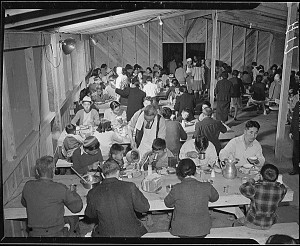On February 19, 1942, President Franklin D. Roosevelt signed Executive Order 9066 into commission. This federal mandate condoned the forced removal and incarceration of all Japanese Americans on the West Coast into inland concentration camps. This order provided Roosevelt with the ability “to prescribe military areas… from which any or all persons may be excluded.” Public Law 503, set in place a month later, supplied Executive Order 9066 with the authority to impose these military orders onto Japanese American communities. Consequently, roughly 110,000 Japanese Americans on the West Coast were removed from their homes with little to no regard for their civil liberties. Despite the apparent negligence of legitimate legality, the Supreme Court upheld the order in the case of Korematsu v. United States. Years later, it was revealed that the federal government withheld critical evidence that presented contrary evidence for the claim of “military necessity.” On February 19, 1976, President Gerald Ford terminated Executive Order 9066 and its subsequent impact by signing Proclamation 4417. (Niiya n.p.).
The authorization and enforcement of Executive Order 9066 can be attributed to the atmosphere of fear and uncertainty that developed following the bombings of Pearl Harbor. In the wake of these attacks, Americans rapidly became fearful that their communities would be targeted next. In facing extreme acts of violence, it is often common behavior to irrationally strike out at those who can be held accountable or even those who can be linked to the guilty parties. In the case of Executive Order 9066, the federal government certainly utilized the public reaction to bolster their cause. As public paranoia of Japanese Americans increased, government leaders began to take action: “early in 1942 the state’s entire congressional delegation – along with the delegations from Oregon and Washington – began to lobby the federal government to do ‘something’ about the Japanese Americans in their midst” (Daniels n.p.). This patriotic fervor that condoned an act of ignorance, naturally, had an exceptionally negative impact on Japanese Americans.
 In faced with the forcible removal from their homes, Japanese Americans had little choice but to abandon much of their personal wealth as well as face the systemic invalidation of their ethnic identity. Japanese Americans were separated from their homes and a large portion of their property as they were interned within “ten desolate concentration camps, officially called ‘relocation centers.’” (Daniels n.p.). Given the fast paced nature of this timeline, many Japanese Americans were forced to sell off their property and goods at dramatically lessened prices. Furthermore, the legal declaration that they were dangerous based solely on their ethnicity had a detrimental impact on Japanese Americans. As is expected, the process of internment and removal marked a significant period of “emotional upheaval” for Japanese Americans. As Roger Daniels states, Executive Order 9066 serves as a “grim reminder of how undemocratically a democracy can react in a time of crisis” (Daniels).
In faced with the forcible removal from their homes, Japanese Americans had little choice but to abandon much of their personal wealth as well as face the systemic invalidation of their ethnic identity. Japanese Americans were separated from their homes and a large portion of their property as they were interned within “ten desolate concentration camps, officially called ‘relocation centers.’” (Daniels n.p.). Given the fast paced nature of this timeline, many Japanese Americans were forced to sell off their property and goods at dramatically lessened prices. Furthermore, the legal declaration that they were dangerous based solely on their ethnicity had a detrimental impact on Japanese Americans. As is expected, the process of internment and removal marked a significant period of “emotional upheaval” for Japanese Americans. As Roger Daniels states, Executive Order 9066 serves as a “grim reminder of how undemocratically a democracy can react in a time of crisis” (Daniels).
— Kate Wall, December, 2015
Suggestions for Further Reading:
- “Report of the Commission on Wartime Relocation and Internment of Civilians.” In Roy L. Brooks, ed., When Sorry Isn’t Enough: The Controversy over Apologies and Reparations for Human Injustice, 171-76. New York: New York University Press, 1999.
- Daniels, Roger. “Milestones in California History: Executive Order #9066 (Feb. 19, 1942).” California History 70, no. 4 (December 1991): n.p.
- Robinson, Greg. By Order of the President: FDR and the Internment of Japanese Americans. Cambridge, Mass.: Harvard University Press, 2001.
- Roosevelt, Franklin D. “Executive Order 9066: Authorizing the Secretary of War to Prescribe Military Areas February 19, 1942” In Roy L. Brooks, ed., When Sorry Isn’t Enough: The Controversy over Apologies and Reparations for Human Injustice, 169-170. New York: New York University Press, 1999.
Featured Image: Japanese Internment Camp , cropped for use here. Used according to the terms of the Creative Commons License.
Image 1: Internment Camp, Field, cropped for use here. Used according to the terms of the Creative Commons License.
Image 2: Manzanar Dining Hall, cropped for use here. Used according to the terms of the Creative Commons License.

